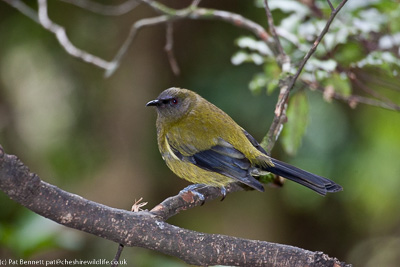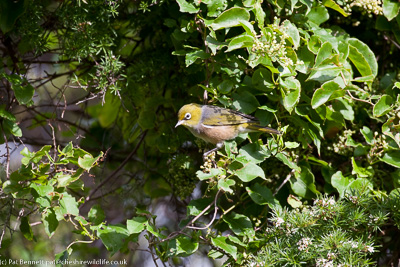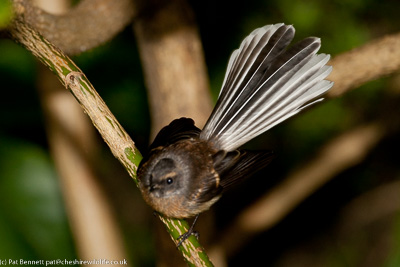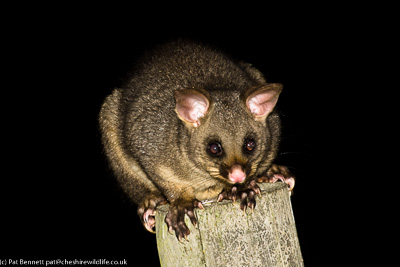Dunedin is like an amphitheatre and Otago harbour its stage, stretching into the distance towards the Pacific Ocean. As I walk across the park from Sue’s house, a few red-billed gulls swoop above me, on the lookout for scraps, but the ground birds are all European – blackbirds, thrushes and sparrows. Crossing a road swooping down the amphitheatre towards downtown Dunedin, I walk along Queen’s Drive under the mainly native trees of the Town Belt, and I am greeted almost immediately by the instantly recognizable calls of the bellbird.

During this visit, I have been setting one of my camera traps in this woodland, and after moderate success by a stream and absolutely nothing on a windfall tree (no mice around), I have found a wonderful site which at first sight seemed to be just a puddle of water at the bottom of a dip in the woodland. In fact, a small stream just a few inches wide issued from the puddle and proceeded downhill, almost completely hidden by the ground cover. After setting up the camera to look at the little pool, I found that this tiny habitat was very attractive to small birds, producing over 150 video clips of birds coming down to drink in a day. Encouraged by the information from the camera trap, I spent time in person, over several sessions, sitting beside the pool without any camouflage, relying on the trusting nature of New Zealand native birds. Sure enough, I was rewarded with close encounters – within three yards.
The most common visitors were silvereye, who came down from twig to twig through the brush to the tiny stream which arose from the pool at the bottom of the hollow below the road. They usually arrived in small parties, bathed either singly or in groups up to four, and then went off about their business.

While the silvereye simply ignored me, I have been inspected on each occasion I have spent time there, and soon after my arrival. The inspectors are New Zealand’s most spectacular small bird, the fantail. I don’t know whether they are extremely curious or have a highly developed sense of territory, but they seem to turn the bird-watching order of things upside down. In most situations, we have to move around unobtrusively, to be quiet, to help our visual sense with binoculars or scopes. Here in New Zealand, if you take a walk in native bush, more often than not you are greeted by this small bird, fanning its long, brilliant white tail around to maximum visual effect, and whirring from perch to perch nearby while glaring at you with a proprietorial body language which clearly states “Git orff moi land!”

Despite their apparent accessibility, they are extremely difficult to photograph because they are continually on the move, and the tail is continually flashed open and shut. This makes it difficult to get both eye and tail critically sharp with the tail open, and as they are usually found in poorly lit woodland, it is impossible to get the shutter speed to stop movement blur and the small aperture to get the eye sharp and the tail reasonably so.
My purpose in setting up the camera trap in the Town Belt was not only to find suitable places to photograph these birds, but to see what wildlife was around at night. New Zealand”s attitude towards its wildlife is ambivalent – birds are good, but mammals are nearly all bad. This is because the land mammals are from elsewhere and have been brought in, deliberately but sometimes accidentally, by man. Mostly predators, they have had a baleful effect on much of the native wildlife, which are mostly birds, which has evolved in the absence of mammalian predators.
Every few days, I walked down to the wood and replaced the SD card in the camera with an empty one, and then walked back to see what had happened in that time. The first mammal to show up was a cat, and we can see from its behaviour in this video clip why it is such a danger to wildlife both here in New Zealand and in the UK.
I recorded cats at night six times on my camera during a period of five weeks. I also recorded possums six times – the brush-tailed possum originates in Australia, and has colonised New Zealand to the point where they are a focus of eradication campaigns involving trapping, ground baiting with poison, and even the aerial distribution of poisons.

It is a threat to the eggs and young of native birds, and also to growing shoots on native trees, but the main reason why possums attract such expensive attention is the fact that they are a threat to New Zealand’s agricultural industry, being a vector of bovine TB.
Despite all the effort, possums are doing well in Dunedin’s town belt. Another unwelcome mammal, a hedgehog, showed up once – unwelcome because they eat the eggs and young of ground-nesting birds. However, the most common mammal, unsurprisingly, turned out to be the rat, scoring 21 hits on video. Judging by its climbing ability, I think it may be the ship rat.
Towards the end of our stay in New Zealand, the camera turned up a daytime video clip of a stoat.
When I looked at the time when this clip was recorded, I was amazed to find that it was just seven minutes before I was standing at the camera, changing the memory card. This means that I was just entering the wood to the right when the stoat disappears stage left – apparently in response to my appearance. How many other occasions have there been, in an apparently barren and uninteresting habitat, when wildlife has tutted at my arrival on the scene and reluctantly made itself scarce?